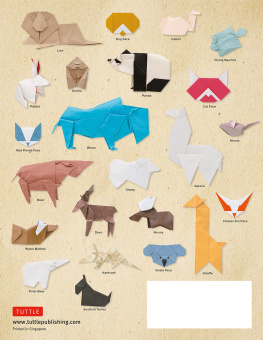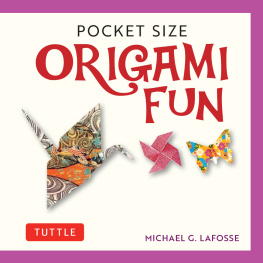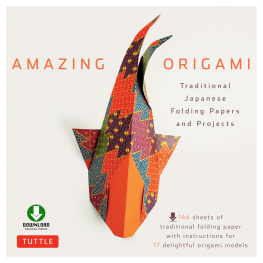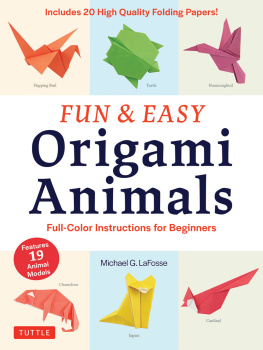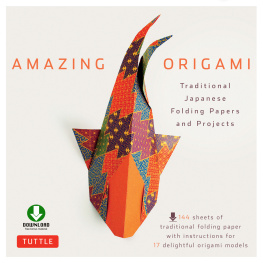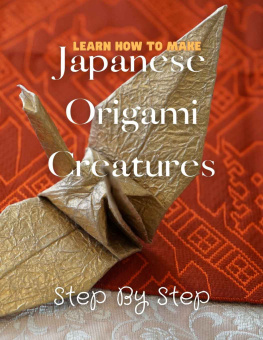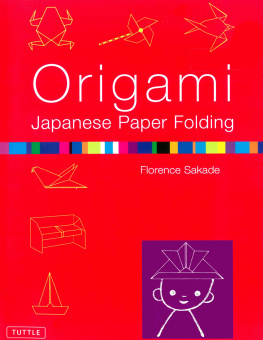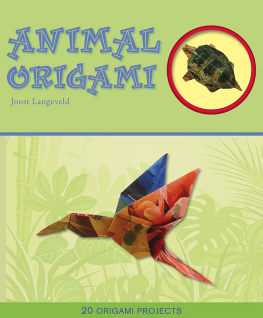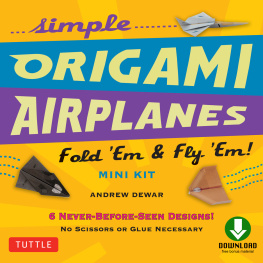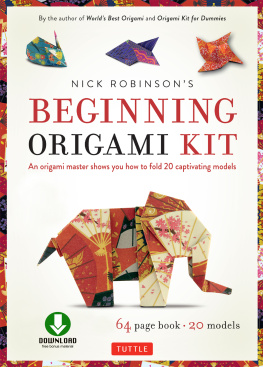Table of Contents
Guide
REALISTIC
ORIGAMI
ANIMALS
FUMIAKI KAWAHATA
CONTENTS
The Beauty of Animals
Most animals have four legs, a head and a tail, but there is virtually limitless
variety in the expression of the forms taken by the many different animals
of the world. In order to live in their oftentimes challenging or even harsh
habitats, animals have evolved into all kinds of unique, beautiful shapes.
Similarly, origami should be adapted to mimic these forms. You cant capture
the beautiful shape of an animal in origami simply by folding a head, a tail
and legs. I took it as a creative challenge to express the unique characteristics
of each animal as faithfully as I could through the medium of origami.
All of the origami animals in this book are folded with a single piece of
paper, without any cuts. This too was a challenge I set for myself as I worked
on creating the pieces. I am confident that the quintessential nature of these
animals will come alive for you as you fold them.
Fumiaki Kawahata
ORIGAMI SYMBOLS
Valley fold
Mountain fold
Imaginary or hidden line
Fold toward you
Fold away from you
Unfold the folded part
Make a crease
Bring points together
Reference point
Insert inside
Pull, shift
Blow air to inflate, or
otherwise open a cavity
Indicates the area to be
opened up
Push, sink
Make this area rounded
Enlarged diagram
Reduced diagram
Turn over horizontally
Rotate
Same angle
Same length
Right angle
Fold in the same way
BASIC ORIGAMI FOLDS
Valley fold
Mountain fold
Inside-reverse fold
Outside-reverse fold
Step fold
Step fold
Sink
Petal fold
Dog Face
Beginner
Recommended paper size: 6-inch (15-cm) square
All animals have characteristic faces. Lets start by folding a
cute dog face. The first step is to fold the paper into equal
thirds. Fold as accurately as possible.
Make a pinch mark in the middle
of the top edge.
Install a crease connecting
the points indicated by the
filled circles ().
Install diagonal creases.
Install creases. Their intersection
should occur at the point indi
cated by the filled circle ().
Install creases so the
points indicated by the
open circles () align.
Fold in half diagonally.
Fold the top flap.
Fold up at a point one third of the
distance between the filled circles ().
Fold along the existing creases.
Using the point indicated by the filled circle
() as the landmark, fold the upper layer
upward as you spread, and then flatten, the
triangular parts on either side.
Fold behind.
Cat Face
Beginner
Recommended paper size: 6-inch (15-cm) square
Lets fold a cute cat face. Animals are great subjects for
origami, even when its just their faces. The positions of
the chin and nose arent fixed, so try folding them at any
position you like.
Install diagonal creases.
Make creases by bisecting the angle on
both sides.
Fold both sides to the vertical
center crease. Unfold.
Fold to the center.
Fold so the points indicated
by the open circles () align.
Swing the flap down.
Mountain fold
behind.
Fold along the existing creases.
Fold so the points indicated
by the open circles () align.
Open the paper up.
Fold the flaps to the
vertical center crease.
Fold up along the existing creases.
Open the pockets and flatten.
Pull out the hidden flap
and bring it to the top.
Mountain fold behind.
Fold down the nose.
Fennec Fox Face
Beginner
Recommended paper size: 6-inch (15-cm) square
The fennec fox is a nocturnal member of the canine family
that lives in the desert regions of Africa. This model can be
come unbalanced because of its long ears, so fold it carefully.
Install a crease.
Fold to the vertical center crease.
Fold so the points
indicated by the open
circles () align.
Fold the triangle.
Open up and flatten
to form a pocket.
Pick up the triangle in the
center and fold behind.
Fold the top down and in
sert the tip into the pocket.
Pull outward, using the points indicated
by filled circles () as landmarks.
Fold and unfold so the points indicated by
filled circles () are connected by creases.
Fold so the edges indicated
by the bold lines align.
Fold so the points indicated by filled
circles () are connected by creases.
Open up.
Open up.
Fold the right side in the same way as
steps 1415 to create a mirrored crease.
Fold the right side in the
same way as steps 1718.
Pull inward and fold.
Turn the paper over. Make step
folds using the existing creases.
Fold the top down.
Red Panda Face
Beginner
Recommended paper size: 6-inch (15-cm) square
This animal has a big tail and unique markings on its face.
I have created an abstract version of the face markings in
this origami version; you can make all kinds of red pandas
by using papers in various colors.
Install creases.
Make additional creases so
the bottom edges meet the
central horizontal crease.
Fold in the sides to the
vertical central crease.
Fold so the points indicated by
the open circles () align. Unfold.
Step fold.
Fold up to the edge of the paper, bisecting the angle.
Fold so the points indicated
by the open circles () align.
Pick up the corner and fold.
Open up the flap and flatten it.
Fold down so the points indicated
by the open circles () align.
Fold out in triangular
flaps to each side.
Fold up the triangular
flap from behind.
Fold the top point forward, and
tuck the tip into the pocket.
Fold the corners behind.
Fox
Beginner
Recommended paper size: 6-inch (15-cm) square
The fox is a member of the canine family, and is famous for
its long, bushy tail and its high intelligence. Puff up the tail
at the end to make it look three dimensional. You can add
a little glue to keep the belly part closed if you prefer.
Install creases.
Fold so the points indicated
by the open circles () align.
Pick up the corners
and fold down.
Fold using the point indicated by
the filled circle () as a landmark.
Fold in the sides so they meet
at the vertical central crease.
Fold so the points
indicated by the open
circles () align. Unfold.
Open up and flatten.
Fold in half.
Fold out.
Fold using the points indicated
by filled circles () as landmarks.
Make an outside-reverse fold
along the existing crease to
stand the tail up.
Fold so the points indicated by the

